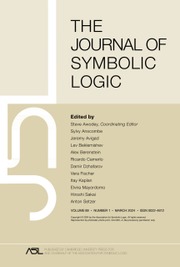Article contents
Decidable subspaces and recursively enumerable subspaces
Published online by Cambridge University Press: 12 March 2014
Abstract
A subspace V of an infinite dimensional fully effective vector space V∞ is called decidable if V is r.e. and there exists an r.e. W such that V ⊕ W = V∞. These subspaces of V∞ are natural analogues of recursive subsets of ω. The set of r.e. subspaces forms a lattice L(V∞) and the set of decidable subspaces forms a lower semilattice S(V∞). We analyse S(V∞) and its relationship with L(V∞). We show:
Proposition. Let U, V, W ∈ L(V∞) where U is infinite dimensional andU ⊕ V = W. Then there exists a decidable subspace D such that U ⊕ D = W.
Corollary. Any r.e. subspace can be expressed as the direct sum of two decidable subspaces.
These results allow us to show:
Proposition. The first order theory of the lower semilattice of decidable subspaces, Th(S(V∞), is undecidable.
This contrasts sharply with the result for recursive sets.
Finally we examine various generalizations of our results. In particular we analyse S*(V∞), that is, S(V∞) modulo finite dimensional subspaces. We show S*(V∞) is not a lattice.
Information
- Type
- Research Article
- Information
- Copyright
- Copyright © Association for Symbolic Logic 1984
References
REFERENCES
- 16
- Cited by

